Indiana University of Pennsylvania celebrated “a milestone moment” Wednesday with a formal groundbreaking ceremony for John J. and Char Kopchick Hall, a $90-million, 142,536 square foot science and mathematics facility.

The building, which will be home to the John J. and Char Kopchick College of Natural Sciences and Mathematics, includes more than 51,600 square feet of laboratory space. It is sited facing the Oak Grove and will be part of the center of campus.
There will be a number of common spaces in the building—not just for science majors, but for all students—in order to showcase science and mathematics to the community. The facility is designed to be state of the art, flexible, offering both teaching and research labs, and reflecting the best thinking of what will be needed for science teaching and learning for the next 20 years.
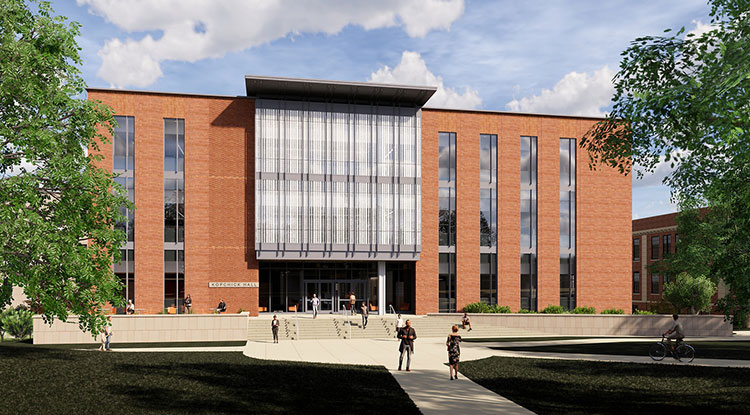 In addition to its laboratory spaces, which include 43 research lab modules – the building has almost 10,000 square feet of collaboration space and 8,000 feet of formal teaching space, including three flexible classrooms. Some of the facility's special features include a planetarium, imaging lab, laser lab, anatomy lab, and roof terrace and partial green roof for research.
In addition to its laboratory spaces, which include 43 research lab modules – the building has almost 10,000 square feet of collaboration space and 8,000 feet of formal teaching space, including three flexible classrooms. Some of the facility's special features include a planetarium, imaging lab, laser lab, anatomy lab, and roof terrace and partial green roof for research.
Construction for the facility will be underway this fall. Faculty and staff will move into the building in summer 2023; students will be in the building for classes for the fall 2023 semester.
In opening the ceremony, IUP Vice President for University Advancement Khatmeh Osseiran-Hanna described the new facility as “the epicenter of all our STEM work. It will provide our students with top-notch opportunities and our faculty members with a new home that will allow them to expand research and explore new ways of sharing their love of science and mathematics.”
Osseiran-Hanna also spoke to how the building points to IUP's future.
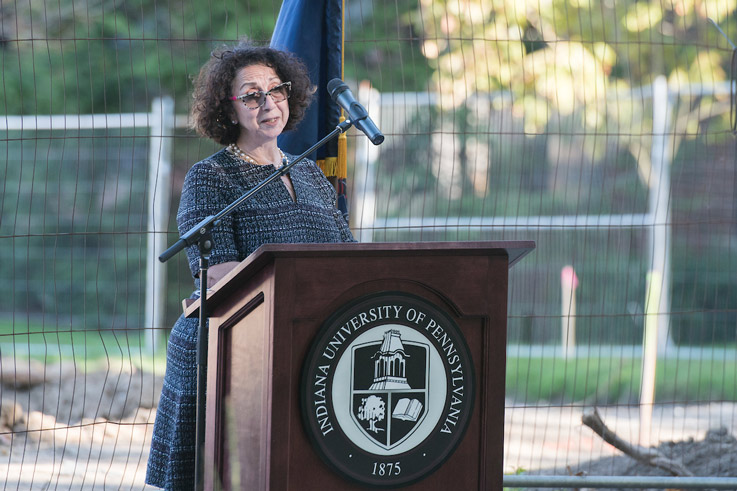 “We want to be leaders in research and discovery. We want to be known as a destination for curious scientists and mathematicians who want to learn more, and then share what they have discovered. We already have a great reputation for our academic programs, and this building will give us the platform to set us apart; to reach cutting edge heights.
“We want to be leaders in research and discovery. We want to be known as a destination for curious scientists and mathematicians who want to learn more, and then share what they have discovered. We already have a great reputation for our academic programs, and this building will give us the platform to set us apart; to reach cutting edge heights.
“It took us a few years to get to this point, we knew we would make it. The Imagine Unlimited campaign began in Academic Year 2014–15 with a goal of raising $40 million. But once we got started and the momentum began building, we knew we had something special.
“From the early phase, when Bill and Audrey Madia committed to chair the comprehensive Campaign for IUP and committed to more than $1 million for this incredible initiative, and when Tim and Deb Cejka were the impetus with their significant outright $5 million gift, which they rounded to $7 million to ensure that we break ground today so that we can dream up this new building.”
Osseiran-Hanna said that with the Kopchick's gift of $23 million in April 2018—the largest gift in IUP's history—it pushed Imagine Unlimited past its original goal.
“John and Char's gift allowed us to reimagine the finish line for the campaign, enabling us to set it at $75 million,” a goal she said that the university will be reaching in October.
IUP President Michael Driscoll recognized how the building will set IUP apart and will provide great opportunities for IUP students.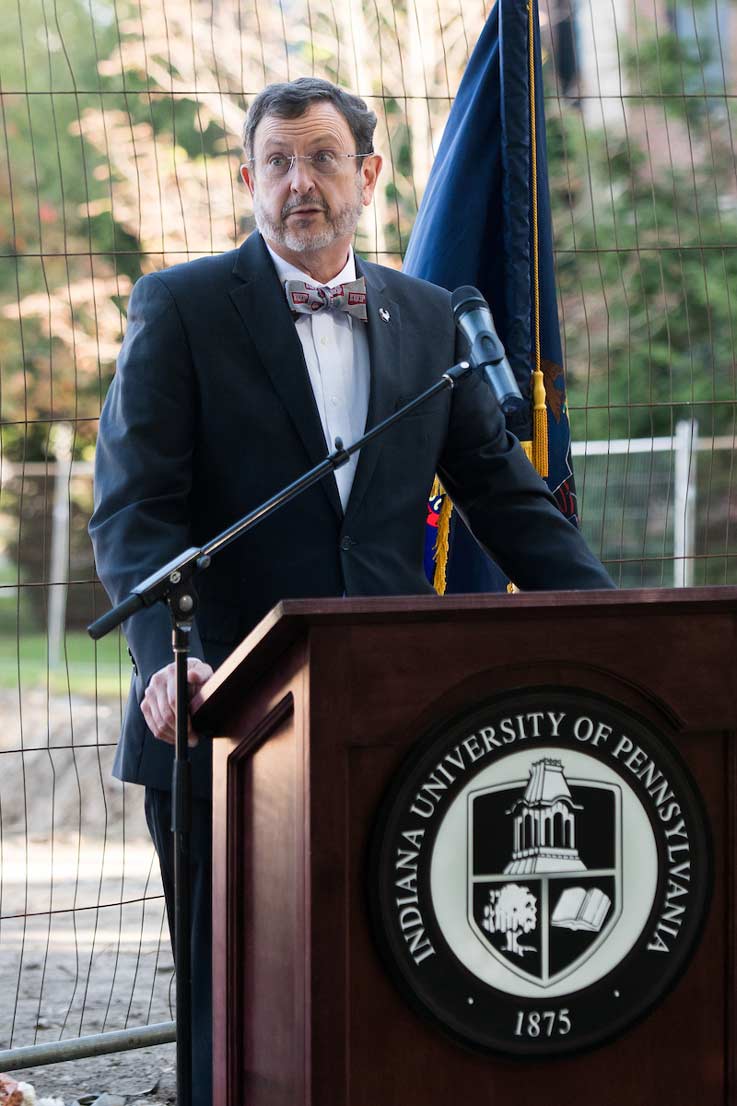
“The real IUP, the one we know and love, is focused on our students and providing them with great opportunities. One of the phrases I like to use to separate us from the sea of sameness out there is ‘Our town is Indiana, our state is Pennsylvania, but our reach is the entire world.' It is a true statement, but it is only words. It is a nice turn of a phrase, but it is hollow if we don't take action and back it up.
“Here today, as we are about to break ground on John J. and Char Kopchick Hall, we are not just talking; we are walking the walk—and we are doing it with giant steps. This building, once completed, will provide our students a place to immerse themselves in the world of science and mathematics. Here they will do more than be in awe of new discoveries; they will make them. They will have the equipment and facilities to take their education to a level that most undergraduate students do not get until grad school, if at all. And they will do it while working side-by-side with faculty members who have a passion for STEM—Science, Technology, Engineering, and Mathematics—who are experienced teachers and cutting-edge researchers, and who are driven to discover more,” Driscoll said.
Sam Smith, chair of the IUP Council of Trustees and vice chair of the Board of Governors of the Pennsylvania State System of Higher Education and chair of the Board of Governors Audit and Compliance Committee, recognized the support IUP gets from the Pennsylvania Department of General Services and the alumni and friends of the university as key to “bringing this state-of-the-art science and mathematics building to life, which reinforces the profound leadership role that IUP has taken in STEM education in western Pennsylvania.”

“One of the things that the state system has been focusing on is that we meet the demands of our students. Buildings run their life cycles, so here we are, providing them with a learning environment that adequately prepares them for future employers seeking more graduates in STEM and health professions. There is no doubt that Kopchick Hall will be the most advanced in its state-of-the-art status among the STEM facilities in the State System universities with the best educational delivery and research capacity for these students,” Smith said.
IUP's Council of Trustees approved naming both the College of Natural Sciences and Mathematics and the new building in honor of IUP alumni Dr. John and Char Kopchick in December 2018.
The Kopchicks, who are members of the national campaign cabinet of IUP's Imagine Unlimited comprehensive campaign, announced a $23-million donation to IUP in April 2018 for science and mathematics initiatives at IUP.
John Kopchick earned a bachelor's degree in 1972 and a master's degree in 1975 from IUP, both in biology. Char Kopchick graduated from IUP with an education degree in 1973. Currently living in Athens, Ohio, John Kopchick is a professor of molecular biology and the Goll-Ohio Eminent Scholar at Ohio University; his wife, Char Kopchick, is the assistant dean of students there. He is a co-inventor of the drug Somavert, which combats acromegaly, a growth hormone disorder. John and Char Kopchick were raised in Indiana and Sagamore, Armstrong County, respectively.
Both Kopchicks spoke during the event.
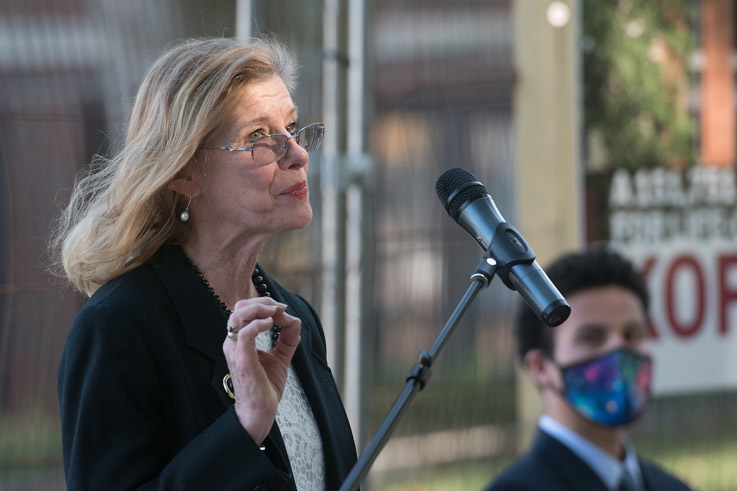 In her remarks, Char Kopchick spoke to the different meanings of the words “groundbreaking” and “building.”
In her remarks, Char Kopchick spoke to the different meanings of the words “groundbreaking” and “building.”
“Groundbreaking, as a verb, is sod cutting, or turning the first sod as a construction project. But when its used as an adjective, groundbreaking is pioneering a new endeavor in the field of inquiry—in other words, discovery and innovation. Building, when used as a noun, a building is a structure with roof and walls.… But when building is used as a verb, it is the process of creating something that is used as a basis for further progress and development. So, what this groundbreaking means to me, and what I would like you all to remember about today's groundbreaking, is that today is much more than turning the first sod of the construction of what is going to be a new and amazing building. It is about the groundbreaking things that are going to occur within its walls. It is about the faculty and students who will discover remarkable things by being innovative, and these same faculty and students will pioneer new fields of inquiry in science and mathematics.
“Most importantly, it is about our students—our students building a solid foundation for their futures through all the experiential learning that will take place in Kopchick Hall. I am really excited to think about all those groundbreaking opportunities that will soon occur, and I know you are, too.”
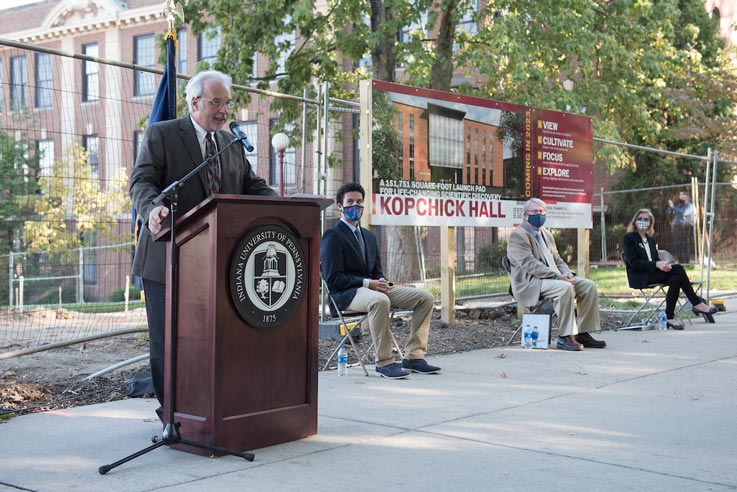
Kopchick talked about the fondness he has for Weyandt Hall and his history and affection for his faculty mentors, and expressed gratitude for the fact that he was able to see his father, who worked in the building, every day for the seven years that John Kopchick studied in the building. He stressed the importance of those who taught him, and spoke to one of his former math professors, who told him after he missed a question on an exam, “John, this is unacceptable. You need to bear down boy and have as much passion about math as you do about baseball.”
“I remember that phrase: bear down and have passion. Words do matter and what professors and faculty and administrators say here can and will leave lasting impressions on students. Thanks to all the past, present and all faculty who helped in teaching us,” Kopchick said.
IUP raised $9.7 million for the building construction to satisfy the financial match required by the Commonwealth of Pennsylvania Department of General Services. The announcement of the completion of the match was made at the 2018 Celebration of Philanthropy event upon the news of an additional $2 million to the $5 million already given by 1973 graduates Tim and Deb Cejka. Tim Cejka is a member of IUP's Council of Trustees, the National Campaign Cabinet, and is co-chair of the Natural Sciences and Mathematics Deans Advancement Council.

In May 2018, IUP's Council of Trustees honored the Cejkas with the naming of the IUP planetarium and its atrium as the Cejka Planetarium.
During his remarks, Tim Cejka talked about the impact IUP had on his future.
“I didn't just learn about science and other disciplines at IUP. I also learned to love learning, and at its essence, that's what science is really all about. Science doesn't end. There's an infinite number of discoveries that can be made, and you need that love of learning to go on that journey. Deb and I are a part of this project because we see this as an investment in the future. Not just the future of science and math students or of the university, but in our world,” Cejka said.
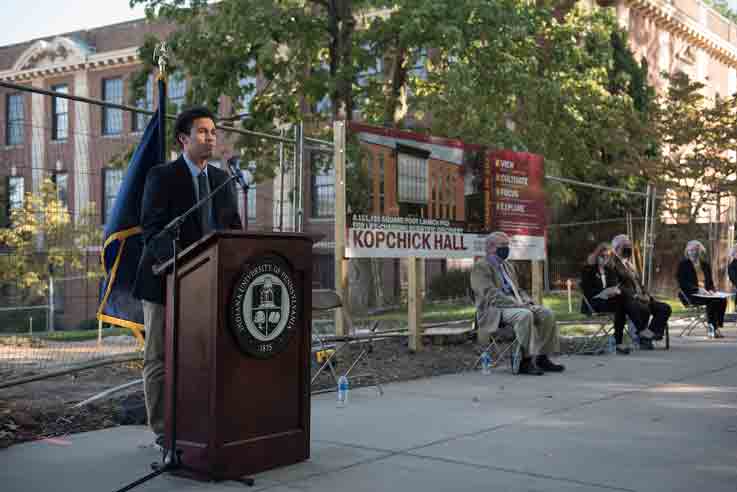
Marcos Zegarra, a junior physics and pre-engineering major and mathematics minor from Monroeville in IUP's Cook Honors College, served as the student speaker for the groundbreaking event. He recognized and thanked “the strong faculty” he has had at IUP, and thanked them for “teaching us, mentoring us, and giving us memories that we will keep forever. I feel like you do not hear it enough so, thank you.”
Deanne Snavely, dean of the Kopchick College of Natural Sciences and Mathematics, spoke to the Kopchick College's vision for the facility.
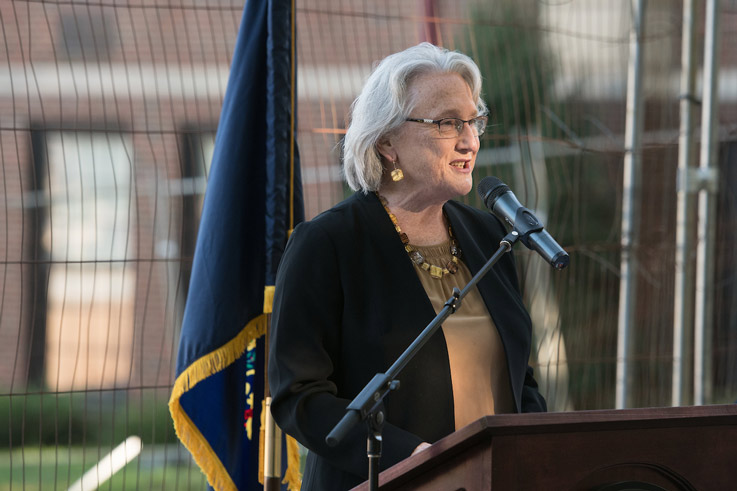
“The design of this building realizes, in a physical space, our college vision of ‘We change lives through science and math, our graduates change the world as educators, scientists, and leaders.' We developed four guiding principles for the building design: experience, then community, then flexibility, then visibility. What is the experience of the people who work and learn in, or just pass through this building? Can we create a community of learners and innovators and invite people to join our community? Science advances and society changes, can this building be flexible enough to accommodate these future demands? And then, can we make sure that science is on display and that everyone could learn a bit of science just by passing through the building?
“From the inviting student collaboration spaces to the shared multi-user instrumentation laboratories to the beautiful science slabs saved from Leonard Hall to be prominently displayed on back of Kopchick Hall—they designed a building consistent with our vision. This building represents the continuation of the high standards that we strive for in science and math at IUP. The efforts of faculty, students, and staff working together to build a scientific community have brought us to this moment of celebration,” Snavely said.
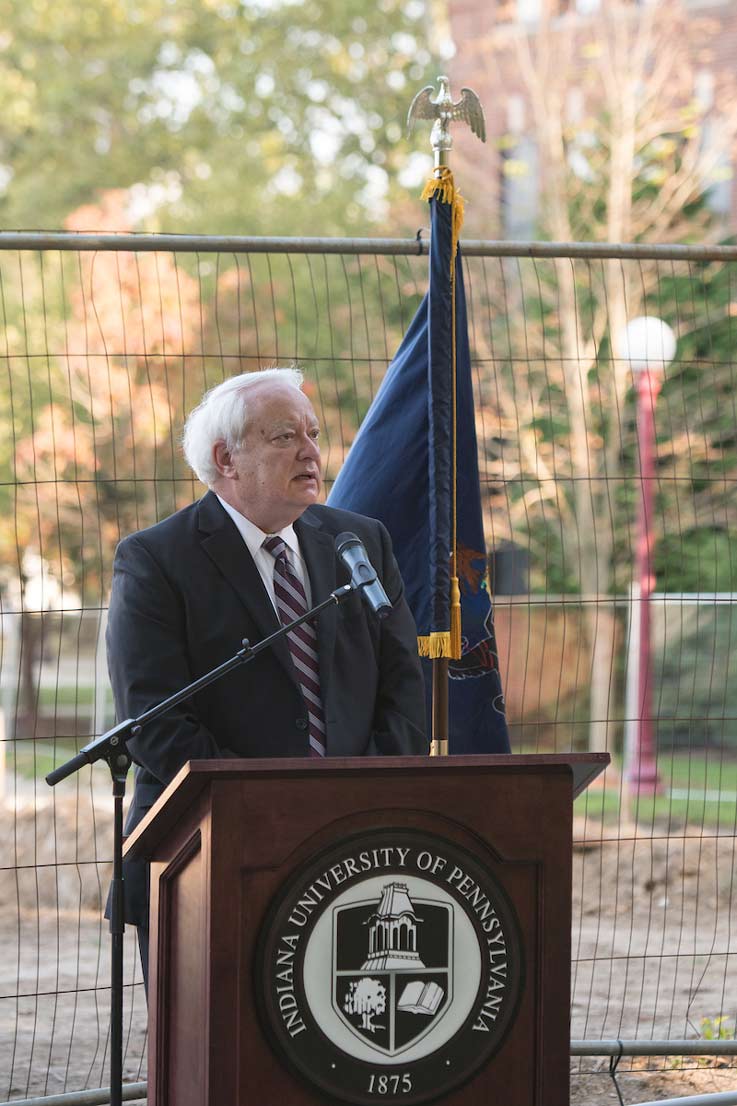 IUP Provost and Vice President of Academic Affairs Timothy Moerland closed the remarks portion of the program.
IUP Provost and Vice President of Academic Affairs Timothy Moerland closed the remarks portion of the program.
“This moment is about more than shovels and dirt. It's about promise. By putting this construction project at the forefront of our fundraising plan the last few years, we made a promise to our students that they will be taught STEM in a facility that rivals any other in the region.
“This building is also a promise from the many, many friends of IUP who have made gifts to make it possible. You who have donated your time and your resources to this do so because you know how important it is to keep promises to our students, those curious ones who will reap the rewards of this opportunity,” Moerland said.
There have been a number of donations to support the Kopchick Hall construction project recognized by IUP's Council of Trustees with naming resolutions for spaces in the new building.
In addition to gifts from the Cejkas, Bill and Audrey DeLaqui Madia, 1969 and 1970 graduates, respectively, made a $1.2 million pledge to the sciences; and Bonnie Harbison Anderson, a 1980 graduate, and her husband Steve, made a gift of $250,000 for the building.
In September 2019, the Council of Trustees honored the Madias with the naming of the IUP Department of Chemistry as the Madia Department of Chemistry. At the September 10 meeting of the Trustees, the Trustees honored Anderson and her husband by naming the Anderson Rotunda in Kopchick Hall in their honor and in memory of Bonnie's parents, Edward J. and Donna M. Harbison.
Development of the plans for the building has been a collaboration among faculty, staff and the College of Natural Sciences and Mathematics Advancement Council, which includes John Kopchick. Building architects are Perfido Weiskof Wagstaff + Goettel.
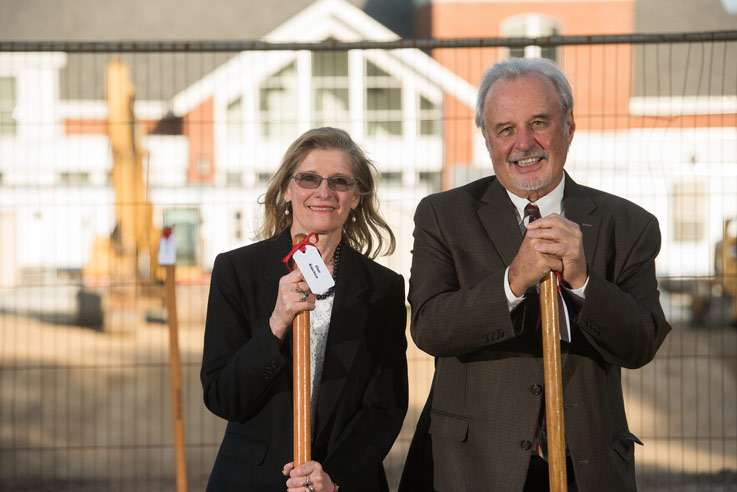 The John J. and Char Kopchick College of Natural Sciences and Mathematics includes the departments and programs of Biochemistry, Biology, Chemistry, Mathematical and Computer Sciences, Environmental Engineering, Geoscience, Physics, Preprofessional Programs, and Psychology. The Kopchick College currently is in Carl S. Weyandt Hall, which was constructed in 1965.
The John J. and Char Kopchick College of Natural Sciences and Mathematics includes the departments and programs of Biochemistry, Biology, Chemistry, Mathematical and Computer Sciences, Environmental Engineering, Geoscience, Physics, Preprofessional Programs, and Psychology. The Kopchick College currently is in Carl S. Weyandt Hall, which was constructed in 1965.
Approximately 65 faculty will be housed in the new Kopchick Hall, which will be home to all of the departments of the Kopchick College. The Department of Mathematical and Computer sciences will remain in Stright Hall; the Department of Psychology will remain in Uhler Hall.
Construction for the project is planned in phases.
The first phase, Leonard Hall demolition, was completed in summer 2018 (the offices and classrooms in that building transitioned to the new College of Humanities and Social Sciences building). Kopchick Hall will be sited on the former Leonard Hall location and on adjacent space currently occupied by Walsh Hall, which was demolished this fall. Laboratories and offices in Walsh Hall were relocated to Weyandt Hall during the 2019–20 academic year. Weyandt Hall will be razed after departments move into Kopchick Hall.
Imagine Unlimited is designed to move IUP forward as a national leader by transforming the student experience through scholarship, program enhancements, and new and modernized facilities, including Kopchick Hall. As of Sept. 1, IUP's Imagine Unlimited Campaign has raised more than $73.6 million toward its $75 million goal.